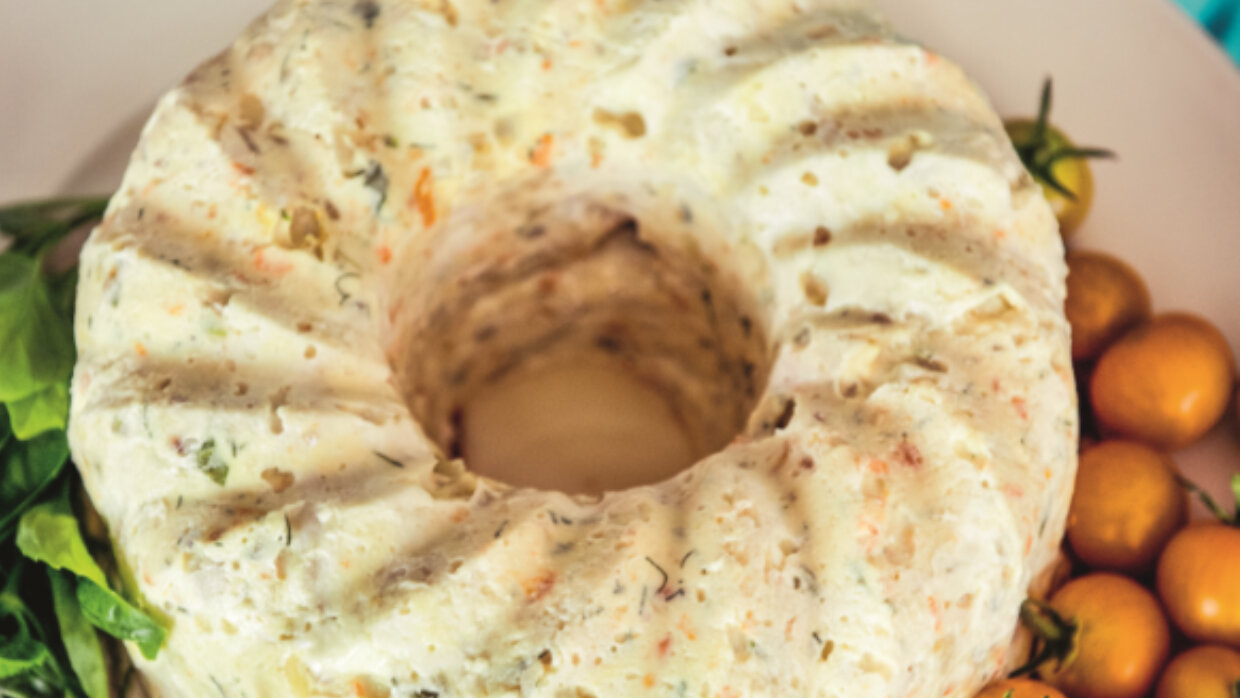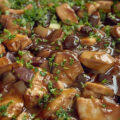Photo by Gabriela Herman
Preparing the gefilte fish in a mold or a springform pan omits fussing with the bones and skin to make a fish stock that you need when making patties, which creates more work and odors in the kitchen. In addition, the white of the fresh fish contrasts beautifully with the fragrant green herbs and the orange carrots, creating a more appealing and colorful dish. Gefilte fish is usually made from a freshwater fish, as found in Eastern European lakes. But saltwater fish is just as flavorful, and easier to find. As usual, Jewish dishes vary according to what is available. Living part of the year in New England, I was surprised at how delicious northeastern halibut could be in this dish.
Ingredients
- Cooking spray
- 2 large sweet onions like Bermuda (about 2 pounds/ 907 grams)
- 2 large carrots peeled
- 3 tablespoons olive oil
- 3 pounds halibut cod, or grouper fillets (1⅓ kg)
- 4 large eggs
- 6 tablespoons matzo meal
- 2 teaspoons kosher salt or to taste
- 2 teaspoons freshly ground white pepper
- 2 tablespoons sugar
- ½ cup chopped fresh dill tarragon, and/or chervil
- ¼ cup chopped fresh Italian parsley plus more for garnish
- Horseradish sauce for serving
Nutritional Facts
Instructions
- Preheat the oven to 325℉, and grease a 12-cup bundt pan with cooking spray.
- Dice the onions, and shred the carrots on a box grater. Sauté them in the oil over medium-high heat until the onions are golden and soft. Set them aside to cool.
- If you can have someone at the fish market grind the fish, all the better. Otherwise, you can pulse it in a food processor fitted with a steel blade, making sure you remove the membranes that may attach themselves to the blade—or use the grinding attachment of a stand mixer.
- Put the cooled onions and carrots into the bowl of a stand mixer fitted with the paddle, along with the ground fish and the eggs, matzo meal, salt, white pepper, sugar, ½ cup (118 ml) water, and herbs. Mix at medium-low speed for about 10 minutes, or until everything is well blended and smooth.
- Pour the mixture into the prepared bundt pan, and smooth out the top. Set the filled Bundt within a larger pan with 2 inches of warm water up the sides of the Bundt. Bake for about an hour, or until the center is solid and a toothpick inserted near the middle comes out clean.
- Cool for about 15 minutes, blot away any water on top, and run a knife around the edges of the pan. Swiftly invert the gefilte fish onto a flat serving plate.
- Refrigerate it for several hours or overnight. Slice it as you would a torte, garnish the slices with parsley, and serve with horseradish sauce, either red or white. Leftovers keep for about 5 days.

















